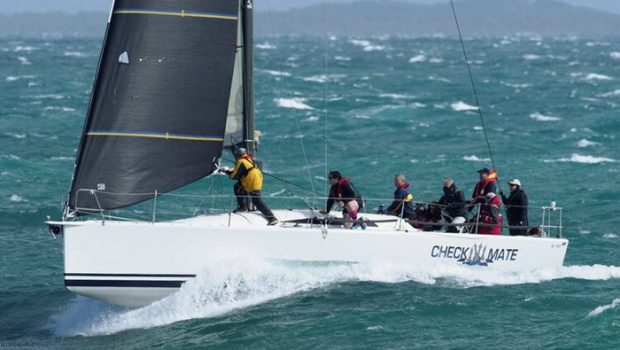Being ready for heavy air racing
Published on October 14th, 2020
Racing is just starting up again in Australia, and with the season opener sailed in heavy air, UK Sailmakers Fremantle’s Geoff Bishop shares what he learned in the race sailing his King 40 Checkmate:
We were surprised that we got race in winds in over 25 knots; not all race committees would consider racing in those conditions. However, we were very glad we did as it was good to test our boat and seamanship.
The heavy air race was mainly a reaching course that really didn’t suit our boat and, luckily, we had decided to use our delivery main due to the forecast for 25 to 35 knots. That sail choice was a good call as we saw 42 knots at one stage.
Before the start of the season, we had a crew get together in our sail loft. We took our boom into the loft and looked at our reefing systems. Everyone learned how the internal jammers inside the boom worked when reefing, we looked at the furling systems on our Code 0 and jib top with all crew present. Just as importantly, we also went over all our safety gear.
This proved to be a very good exercise for the whole crew. For the first time, everyone understood how the furlers worked and understood the ratchets on the Facnor furler plus the top down Karver system on the Code O. They even learned how to pack the asymmetric spinnaker with the elastic binding system and retrieval lines… not that this helped in this race as we did not hoist our downwind sails.
We then had everyone inflate their life jackets and then deflate and inflate again as a self-test. We discussed the emergency steering system and how to deploy it. We also discussed what to do in the event of man overboard. The whole evening was enjoyable and we all learned a lot about the boat and our safety gear.
Now back to the first race of the sailing season; I am glad we had all looked at our reefing system as we set the reef, shook it out, and the set it again during the race. The guys at the front end knew exactly what to do how to jam off the reef lines. We hoisted our jib top on the reaching legs and unfurled and furled it with the ratchet system.
On the second short beat and in 35-40 knots, we were able to quickly reef, and sail the boat well when others where more in survival mode. We made the decision not to hoist the spinnaker and sail the running legs with the #4 gooseswinged (wing-on-wing). The first time downwind with the outboard jib sheet we had reasonable success and were able to make next mark without gybing.
For the leg to the finish, we had 35-38 knots and the downwind angle was very similar to the other leg. This time we connected the spinnaker sheet to the clew of the jib and tweaked it down to a padeye just a little aft of our standard outboard sheeting position. This allowed us to soak down to the finish on the one gybe.
Back at the club we heard about three boats that tried to hoist spinnakers. They all had trouble and all lost valuable time, some losing sails and stanchions in the process. The other boats didn’t sail wing-on-wing and had to either gybe or granny (chicken or cow gybe) on the downwind legs… these boats also had interesting stories to share as well.
Editor’s note: This story was in the UK Newsletter that is distributed free by email. To subscribe, click here.









 We’ll keep your information safe.
We’ll keep your information safe.